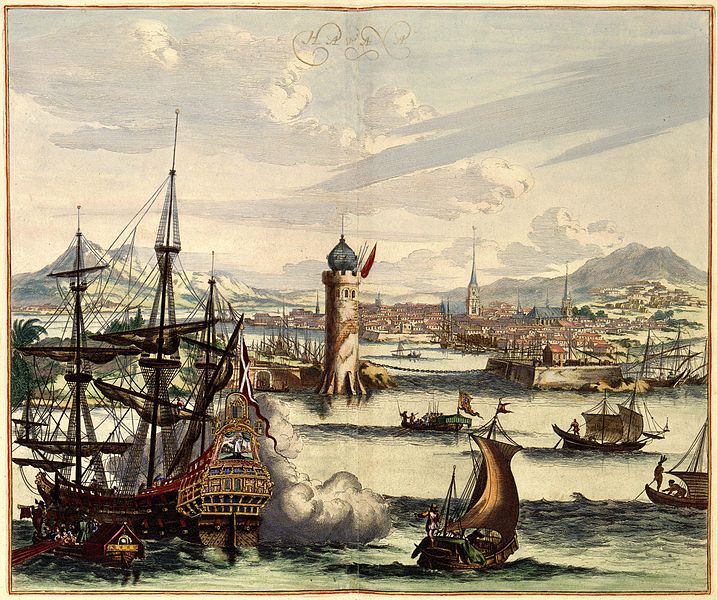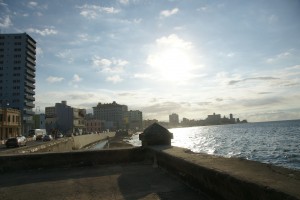Reading Havana
May 4, 2012 by admin
La Habana, the capital of Cuba, has enchanted travelers for centuries. Founded around 1515 by Spanish colonialists, the city quickly gained wealth as a stopping point for ships returning to Spain with the spoils of the conquest of the continent. The city was officially given status in 1592, and the centuries of warfare and pirate raids on the island led to the construction of fortresses and walls.

(Amsterdam, 17th Century image of Havana)
By the 19th century, trade with other North American cities fostered Havana’s transition into a large and elegant metropolis. In 1863, the old walls were taken down to accommodate the city’s rapid growth. At the turn of the 20th century, Cuba was occupied by the United States, before the “Republican Period” began in 1902. The country grew quite wealthy through the increase of tourism and gambling, although capital was concentrated in the hands of a tiny minority. With the revolution of 1959, Havana took on a different image, affected alternately by the Soviet-aesthetic and the scarcity of resources that resulted from the U.S. embargo.

Havana in the 1930s
This brief sketch of a timeline helps demarcate the rich history that has defined Havana’s complex morphology. Like a sprawling patchwork quilt, a palimpsest of different architectures forms this city of two million inhabitants. Walking through Havana is like reading a history lesson; however, this history is not constructed in some linear narrative, but like an undulating stream or a rhizome. Each architectural style–– baroque, neoclassical, art deco, mid-century modern–– appears in the urban fabric at random points, connected by imagined vectors of some shared aesthetic ideal. That is not to say that the city cannot be broken up into areas loosely defined by a singular style. There is Old Havana, Vedado, and other areas with some kind of unified image. But troubling those singular images helps reveal the true complexity that time and circumstance has rendered on to this city.
For example, we can turn to the Malecón. The broad esplanade with its busy road and sea wall is one of the major landmarks of the city. Its construction began in 1901, at the end of the U.S. occupation, and is representative of the changes the city has experienced in just the last century. Built in stretches, the first part of the street was from the Paseo del Prado. In 1923 it reached Vedado, and today it stretches all the way to the Sierra Maestra Hotel. The first part of the Malecón is defined by the dilapidated grandeur of the beginning of the century. There are large arcades and elaborate ornamented buildings with peeling paint and damage from the sea air. Interspliced into this section are large art deco buildings and streamline-modern apartment buildings. Further along the road is the Hotel Nacional de Cuba, the famous luxury hotel built in 1930. Continuing down the coast are the large mid-century modern hotels and casinos that typified the hedonism of the 1950s. The Malecón is a popular destination for both tourists and locals, and a source of income for fishermen.
While at first demarcating the street into these historic sections seems fine, it ignores the everyday use of the city. Considering streets, or cities in general, only through the lens of architects and urbanists can result in fatal inaccuracy. For every city in the world is composed not only of brick and cement, but also of the individuals who pass through it, re-paint their walls, embellish a window with flowers, or scribble on a wall. This change of scope for analysis breathes life into a street that through pictures can seem decaying, but is in actuality constantly changing. This type of reading is particularly relevant in Havana, where a lack of capital and completely different ideological governance from the “mainstream” of advanced capitalism have alternately preserved parts of the city and rendered it completely different from the development-machines of other cities. While we do not see the large-scale urban transformations of American cities in Havana, it is erroneous to imagine the city (or country) as “frozen in time,” a relic of history. For time does not have to pass through a place with a bulldozer, it can radically alter a place as much through the mechanisms of the everyday.
Leave a Reply
You must be logged in to post a comment.




